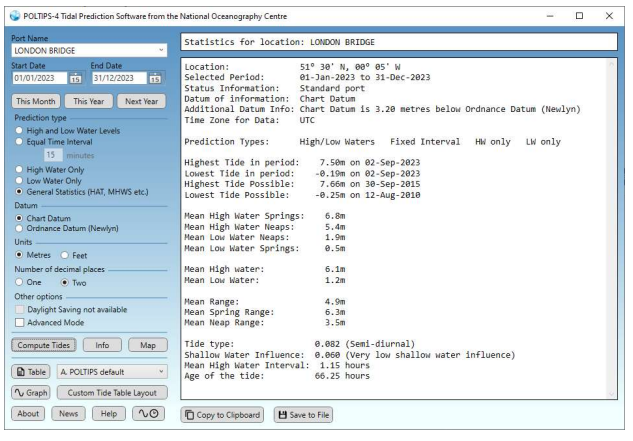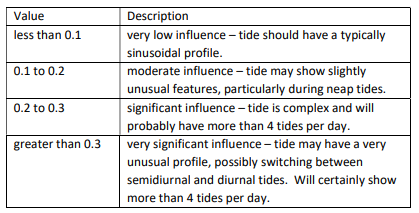Selecting General Statistics as the Prediction Type and clicking Compute Tides gives a number of
different statistical calculations of the tide at the chosen port.

The general statistics output shows some basic information about the port as well as a number of
different statistical results. A few of these require the calculation of a long period of data so this can sometimes take a few seconds to compute (depending on the speed of your computer).
- Highest/Lowest tide in period: the highest and lowest predicted values in the specified period (between the start and end dates). The height is given, along with the date it occurs.
- Highest/Lowest tide possible: these are commonly known as the Highest Astronomical Tide
(HAT) and Lowest Astronomical Tide (LAT) and are computed by calculating the tides for a 20 year period (1997 to 2016) at the specified location and extracting the highest values. It will also show the date it occurred. - Mean High/Low Water Springs/Neaps: computed either directly from the harmonics (in the case of standard ports) or derived directly from the Poltips database (for secondary ports). This information is only given to the nearest 10cm.
- Mean High/Low water: derived directly from harmonics and will not be shown for secondary ports.
- Mean Range / Mean Spring Range / Mean Neap Range: the average difference between high
water and low water. - Tide Type: A numerical value that indicates the tidal characteristics at the location.

- Shallow Water Influence: A numerical value that gives an indication of how complex the tidal patterns are.

- Mean High Water Interval: sometimes known as the lunitidal interval, this is the time between the Moon's transit and the next high water. This value is sometimes used by tidal watches which can give a rough estimate for the times of high water.
- Age of the tide: this is an old term for the lag between new or full moon and the maximum
spring tidal range. This is usually between 30 and 48 hours although it can be as low as just a few hours or in excess of 60 hours.
For further information see Poltips 4 user manual.
